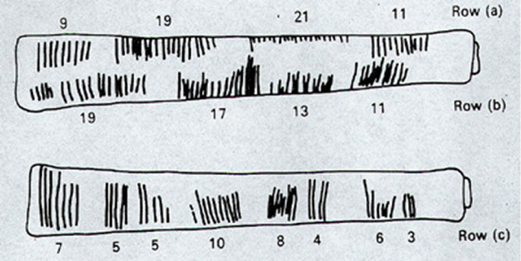After a lot of internet research, all searches for prehistoric maths seem to come back to the Ishango Bone. It was discovered in the Democratic Republic of the Congo in 1960 and is thought to be around 25,000 years old. At a first glance, it’s just a stick with some lines on it and they don’t make any sense.
Initially I thought it was perhaps a primitive tally chart. This would make sense, as the people who used it all those years ago may have needed to count, for example the resources they had or perhaps something like the birth rate. It would also be a very logical way of using numbers and is nothing like our complicated numerical system, as it seems that | =1 and || = 2 and ||| = 3 and so on, compared to our system of numerical not actually depicting the number they represent like this.
Having looked into this more, it is clear that the prehistoric people were far more mathematically advanced than we give them credit for. The Ishango Bone has lines in groups, and the groups are split into 3 rows (a), (b) and (c). (a) shows a group of 9, 19, 21 and 11. (b) shows 19, 17,13 and 11. And (c) shows 7, 5, 10, 8, 4, 6 and 3. Row (a) and (b) both add up to 60, and it is thought that (c) uses multiplication by 2. This suggests that the prehistoric people who used the Ishango Bone must have had a fairly solid understanding of these numbers and been able to use them to aid their everyday life, much like we do.
Further research tells us that more recently the Ishango Bone has been shown to have more markings on it than first thought, and it shows links to the lunar calendar. Claudia Zaslavsky, an Ethnomathematician, wrote in 1991 “Now, who but a woman keeping track of her cycles would need a lunar calendar?”. She suggests that the Ishango Bone was used by a woman or women to keep track of their menstrual cycles. If this is true, then it could mean that the first mathematicians in the world were women, using mathematics to aid them in their everyday lives. This is significant, as even a Google search for ‘famous mathematicians came up with results such as Albert Einstein, Leonardo Pisano Bigollo, Pythagoras, Archimedes and John Napier. This is of course not to take away from all of their mathematical successes, but they are all male.
From a teaching perspective, this is highly informative. I think that it is highly important to take away from this research that when teaching is that generally we see boys going into traditionally male subjects such as mathematics and girls for traditionally female subjects, such as English. However this shows that women can be mathematicians and we, as teachers, should be encouraging this through providing positive role models for them. If the class I was working with was old enough to understand the menstruation part, I would share some of this information with the class to try to encourage girls in the class to do mathematics if it interests them and not be put off thinking that it is for boys. I will also try to remember that the numerical system and how it compared to the one we use and that children will need time to pick it up and therefore not to rush them. From a personal perspective, I am going to try to keep this in mind, but also I think that to remember that the prehistoric people were not as primitive as perhaps I believed before, and I will try to convey this in my teaching if it is ever possible.
Coolman, R (2015) The Ishango Bone: The World’s Oldest Period Tracker?. Available at: http://www.thedailybeast.com/articles/2015/10/06/the-ishango-bone-the-world-s-oldest-period-tracker.html (Accessed: 7 October 2015)
Mastin, L (2010) Prehistoric Mathematics. Available at: http://www.storyofmathematics.com/prehistoric.html (Accessed: 7 October 2015)
Weisstein, E (2015) Ishango Bone. Available at: http://mathworld.wolfram.com/IshangoBone.html (Accessed: 7 October 2015)
Williams, SW (2008) Mathematicians of the African Diaspora. Available at: http://www.math.buffalo.edu/mad/Ancient-Africa/ishango.html (Accessed: 7 October 2015)
Zaslavsky, T (no date) Claudia Zaslavsky. Available at: http://www.math.binghamton.edu/zaslav/cz.html (Accessed: 7 October 2015)



Super informative blog post! Clearly very well researched